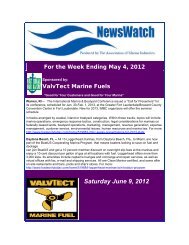Entire Document - California Department of Boating and Waterways ...
Entire Document - California Department of Boating and Waterways ...
Entire Document - California Department of Boating and Waterways ...
Create successful ePaper yourself
Turn your PDF publications into a flip-book with our unique Google optimized e-Paper software.
......................................................................C6.6 Pontoon SpecificationsCommentary:Some older pontoon shells that are still in service were made <strong>of</strong> roto-castpolyethylene. Made two at a time, they came out <strong>of</strong> the molds much like two breadpans connected at their rims. They were cut apart, resulting in two open-toprectangular hollow pontoon shells. Such shells were filled with pre-exp<strong>and</strong>ed foamsnugly inserted into the shells, <strong>and</strong> capped with pressure treated plywood. 10 millpolyethylene sheeting was placed over the open-top foam-filled pontoon before theplywood cap was put on. This procedure helped stiffen the pontoon flanges,strengthened the connection to the dock frame, <strong>and</strong> helped ensure a watertight sealalong the lip <strong>of</strong> the pontoon.When this type <strong>of</strong> polyethylene pontoons are attached to the bottom <strong>of</strong> the frame,typically with galvanized lag screws <strong>and</strong> washers on 4 to 6 inch centers, a 2"x2"pressure treated wood backing strip should be used to insure that the pontoonflanges <strong>and</strong> covers are secured perfectly flat against the dock frame. This will guardagainst puckering <strong>of</strong> the pontoon flanges that tends to occur during warm weatheras the result <strong>of</strong> thermal expansion. Such puckering forms small “mouths” betweenthe lag screws that literally drink water in the splash zone around a pontoon <strong>and</strong>allow it to enter into the pontoon, filling existing air gaps, <strong>and</strong> progressively alteringthe buoyant characteristics. For example, where wind chop occurs primarily on thewarm sunny side <strong>of</strong> an existing dock, pontoons will “sip” water on that side only, <strong>and</strong>the growing internal hydraulic pressure will gradually push the pontoon walls awayfrom the foam cores. This can result in severe listing <strong>of</strong> the pontoons, a situationthat is not usually self-righting.Roto-cast polyethylene pontoons presently being used on marina docks are moldedas self-contained units that are completely enclosed. The flotation foam has to beinjected into the pontoons after the molding process is completed. Such pontoonsare tough, reliable, <strong>and</strong> versatile for use on marina docks.A suggested field method <strong>of</strong> addressing water filled polyethylene pontoons is to drill1 inch diameter holes vertically up through the bottom <strong>of</strong> each pontoon shell about 2inches diagonally from each corner. This will allow water both inside <strong>and</strong> outside thepontoons to equalize. The bottom <strong>of</strong> the pontoons will be several inches below thewaterline, so no fuel, oil or other chemicals floating on the surface will be able toenter the pontoons <strong>and</strong> gradually “melt” the foam. This is an easy, effective, <strong>and</strong>inexpensive method to stabilize older “puckered” plastic pontoons as well as newerones that may have taken on water. Since the primary function <strong>of</strong> the pontoon shellis to protect the foam core, drilling holes in the bottom, well below the water line,does not diminish the integrity <strong>of</strong> the shell or the foam. Do not drill drain holesthrough the sides <strong>of</strong> the pontoons.The above commentary gives clear evidence as to why pontoons should not bepartially filled with foam. If water gets inside a partially filled pontoon, the foam coremay very well float to the top <strong>of</strong> the pontoon shell, allowing even more water toAppendix A -- Section C Commentary - Page 84












